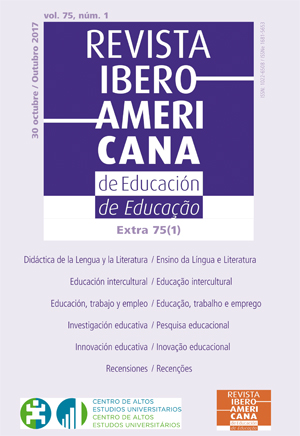The creative dimension when writing, illustrating and musicalising tales around the world
DOI:
https://doi.org/10.35362/rie7511357Keywords:
world tales, dramatisation, creative writing, illustration, musicalisationAbstract
This paper explores the creative dimension of two writing, illustration and musicalisation workshops of tales around the world carried out with Pedagogy students within the TALIS project in a rural campus of the Northeast of Brazil. The main goals were the recovery of the historical memory and cultural heritage of the Paraiba region (Brazil); in-service and pre-service teacher training in line with the principles of Education for Sustainable Development; and the development of creative teaching materials in written and audiovisual formats. The data gathered through questionnaires, semi-structured interviews as well as the analysis of the productions showed a great receptivity and a high degree of engagement of participants with regard to the three creative dimensions dealt with. Moreover, their contributions helped enrich the project, allowing for the integration of innovations regarding the inclusion of new topics, such as the vindication of historical places and figures through the tales; and of new forms of expression, such as the musicalisation of tales and the inclusion of dramatisation as an integral part of the workshops.
Keywords: creative writing; illustration; musicalisation; dramatisation; world tales.
Downloads
References
Alcantud Díaz, M. & Gregori Signes, C. (2014). Audiobooks: improving fluency and instilling literary skills and education for development. Tejuelo: Didáctica de la Lengua y la Literatura, 20, 111-125.
Alvermann, D. & Phelps, S. (1998). Content reading and literacy. Boston: Allyn & Bacon.
Banks, J. A. (2001). Citizenship Education and Diversity: Implications for Teacher Education. .Journal of Teacher Education, 52(1), 5-16.
Banks, J. A. (2007). Educating Citizens in a Multicultural Society. New York: Teachers College Press.
Barron, F. (1955). The disposition toward originality. Journal of Abnormal and Social Psychology, 51, 478 –485.
Bloom, B. S. (Ed.), Engelhart, M.D., Furst, E.J., Hill, W.H., & Krathwohl, D. R. (1956). Taxonomy of educational objectives: the classification of educational goals. Handbook 1: Cognitive domain. New York: David McKay.
Carson, S. H.; Peterson, J. B. & Higgins, D. M. (2005). Reliability, Validity, and Factor Structure of the Creative Achievement Questionnaire. Creativity Research Journal, 17(1), 37-50.
Chambers, J. A. (1969). Beginning a multidimensional theory of creativity. Psychological Reports, 25(3), 779-799.
Cropley, A. J. (2001). Creativity in education and learning: A guide for teachers and educators. London: Kogan Page.
Fink, A.; Benedek, M.; Grabner, R. H.; Staudt, B. & Neubauer, A. C. (2007). Creativity meets neuroscience: Experimental tasks for the neuroscientific study of creative thinking. Methods, 42(1), 68–76.
Freire, P. (1989, 19 ed.). Educação Como Prática da Liberdade. Rio de Janeiro: Paz e Terra.
Guilford, J. P. (1950). Creativity. American Psychologist, 5, 444-454.
Guilford, J. P. (1967). The nature of human intelligence. New York: McGraw-Hill.
Haba Osca, J.; Alcantud Díaz, M. & Peredo Hernández, J. (2015). Taller de Escritura Creativa para el Desarrollo de la Competencia Literaria en Brasil. Didáctica. Lengua y Literatura, 27, 97-110.
Jones, L. (2007). The Student-Centered Classroom. Cambridge: Cambridge University Press.
Kim, K. H. (2006). Is creativity unidimensional or multidimensional? Analyses of the Torrance tests of creative thinking. Creativity Research Journal, 18(3), 251-259.
Krashen, S. (1985). The Input Hypothesis: Issues and Implications. New York: Longman.
Krathwohl, D. R. (2002). A Revision of Bloom’s Taxonomy: An Overview, Theory Into Practice, 41(4), 212-218.
Little, A. W. & Green, A. (2009). Successful globalisation, education and sustainable development. International Journal of Educational Development, 29(2), 166–174.
Lubart, T. I. (2001). Models of the Creative Process: Past, Present and Future. Creativity Research Journal, 13(3-4), 295-308.
Mace, M. A. & Ward, T. (2002). Modeling the Creative Process: A Grounded Theory Analysis of Creativity in the Domain of Art Making. Creativity Research Journal, 14(2), 179-192.
McWilliam, E.; Hearn, G. & Haseman, B. (2008). Transdisciplinarity for creative futures: what barriers and opportunities? Innovations in Education and Teaching International, 45(3), Special Issue: Creativity or conformity in higher education?
Naciones Unidas (1959). Declaration of the Rights of the Child. Proclaimed by the General Assembly, resolution 1386 (XIV), A/RES/14/1386, 20 November 1959, U.N. Doc. A/4354.
Naciones Unidas (1995). The United Nations and Human Rights. New York: Department of Public Information, United Nations.
Nussbaum, M. (2002). Education for Citizenship in an Era of Global Connection. Studies in Philosophy and Education, 21(4), 289–303.
Sadler-Smith, E. (2015) Wallas’ Four-Stage Model of the Creative Process: More Than Meets the Eye? Creativity Research Journal, 27(4), 342-352.
Sawyer, K. (2011). The Cognitive Neuroscience of Creativity: A Critical Review. Creativity Research Journal, 23(2): 137-154.
Sevilla-Pavón, A. (2015). Examining collective authorship in collaborative writing tasks through digital storytelling. European Journal of Open and Distance Learning, 18(1): 1-7. Recuperado de http://www.eurodl.org/?p=current&sp=brief ISSN: 1027-5207.
Srinivasan, N. (2007). Cognitive neuroscience of creativity: EEG based approaches. Methods, 42(1), 109–116.
Todd I. L. (2001) Models of the Creative Process: Past, Present and Future. Creativity Research Journal, 13(3-4), 295-308.
UNESCO (2007). The UN Decade for Education for Sustainable Development (DESD 2005–2014): the first two years. Paris: UNESCO.
UNICEF (1993). Programa de aprendizaje permanente. Bruselas: UNICEF.
Vygotsky, L. (1978). Mind and Society. Cambridge: Harvard University Press.
Wallas, G. (1970): The art of thought. En: Vernon, P.E. (Ed.): Creativity (pp. 91-97, publicación original: 1926, The Art of Thought. New York: Harcourt-Brace). Harmondsworth, Middlesex: Penguin.
How to Cite
Published
Issue
Section
License
Any authors who publish with this journal accept the following terms:















